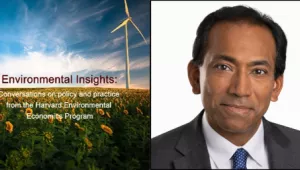
Among the many stories to emerge from COP27, the recent UN conference on climate change, one headline has been surprisingly absent: negotiators in Sharm-El-Sheikh killed the market for voluntary carbon credits. This market, where companies buy credits to “offset” their emissions, has grown to nearly $2 billion amid a flurry of corporate net zero pledges.
COP27 was - in theory - more than just a talking shop for climate bigwigs. Behind the executives and activists is the Conference of the Parties to the Paris Agreement, where delegates update the world’s flagship climate treaty. Despite limelight on issues like loss and damage, this year’s COP also inched forward another critical provision: Article 6.
Article 6 provides for carbon trading between countries by creating a special type of carbon credit that governments can use for their emission reduction commitments under the Paris Agreement. Crucially, Article 6 credits are different from voluntary offsets because when a country sells an Article 6 credit, it must perform an adjustment so as not to count those emissions reductions for its own targets. This process avoids double counting and helps ensure that projects generating Article 6 credits represent additional emissions reductions.
Why, though, is progress on Article 6 a smoking gun for the death of voluntary carbon markets?
First, governments have an incentive to push companies to use Article 6 credits rather than voluntary offsets. Imagine a UK firm that claims to have offset its emissions through voluntary credits, as some have by claiming to be carbon negative. This claim would count for nothing towards the UK national emissions commitment. Article 6 credits, however, do count - why wouldn’t a government use corporate ESG strategies to support its Paris Agreement obligations?
Second, companies may eventually opt for Article 6 credits out of pure economic interest. This is because Article 6 offsets may effectively act as tax credits in future. A case in point is the EU’s Carbon Border Adjustment Mechanism, where foreign firms will pay a tariff on exports into the EU unless they have paid a carbon tax elsewhere. Article 6 credits could function as the equivalent of paying such a tax, as is already the case for Switzerland’s carbon tax on motor fuel. If Article 6 credits reduce a firm’s tax bill, it would be uneconomical to use voluntary offsets instead
Third, once Article 6 credits are available, voluntary credits may carry reputational risk. Firms purchasing offsets are extremely attuned to perception around greenwashing. With internationally approved credits in circulation, buyers may shun their unregulated equivalents for fear of public backlash.
If handled properly, the voluntary carbon market’s demise could actually be positive for reducing emissions. Everyone from the Financial Times to John Oliver has questioned the environmental value of voluntary offsets, especially so-called “emissions avoidance” credits, which theoretically prevent deforestation or avoid emissions such as from future coal plants. These are important objectives - the world needs forests and access to clean energy - but even the most rigorous standards cannot guarantee that those avoided emissions would actually have occurred, or won’t simply relocate.
Ideally, voluntary markets will converge with Article 6, and firms will replace their offsets with Article 6 credits. This may be bad for current investors, as falling demand will bring down prices, but good news for the planet if Article 6 add teeth to companies’ offsetting claims. This looks possible, and in the room at COP27 negotiators pushed to make certain problematic offsets ineligible for Article 6. Indeed, the final rules may exclude emissions avoidance credits, which represent more than 90% of the voluntary market, and nature-based carbon removals, which many view as impermanent.
However, there is also a risk that the opposite occurs: rather than convergence, net zero commitments may be abandoned as firms realize the cost of meeting them with rigorous Article 6 credits. To make carbon markets work therefore, and ensure carbon offsets actually offset emissions, action is needed.
For one, policymakers should push firms to use only Article 6 credits for emissions offsetting. In fact, any business using offsets should have a strategy for Article 6 as simple good practice, cognizant that the market will soon undergo seismic change.
Next, work is needed to buttress Article 6’s environmental integrity and make sure any capital raised by the mechanism is deployed effectively. At COP27, negotiators put the finishing touches on Article 6.2, which allows for bilateral carbon deals between countries. This clears the way for the first Article 6 credits to be issued in 2023.
We present one example of how best to operationalize Article 6 in a recent Harvard Kennedy School Belfer Center paper, which suggests leveraging the mechanism to support blended finance investment in the developing world. Our approach shows how, while the buying and selling of carbon credits is one option, many governments would be better served using Article 6 as a means of investing in projects, rather than purchasing credits. This could de-risks private investment, and help “crowd in” private investment.
Funding climate change mitigation is essential: $3 trillion is needed annually to keep global warming within the Paris Agreement goals. Getting there will require that the Article 6 credits of tomorrow are more than just hot air. Voluntary carbon markets should not die in vain.
Ely Sandler is a former advisor to Morgan Stanley’s international CEO, and the co-author (with Belfer Center's Dan Schrag) of a recent Belfer Center paper on climate finance.
Sandler, Ely. “COP27 May Have Killed the Voluntary Carbon Market: A Better Model Must Take Its Place.” Belfer Center for Science and International Affairs, Harvard Kennedy School, January 3, 2023





